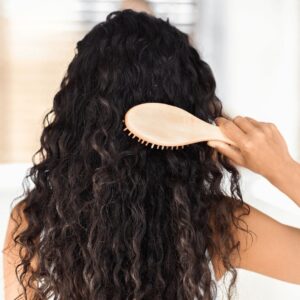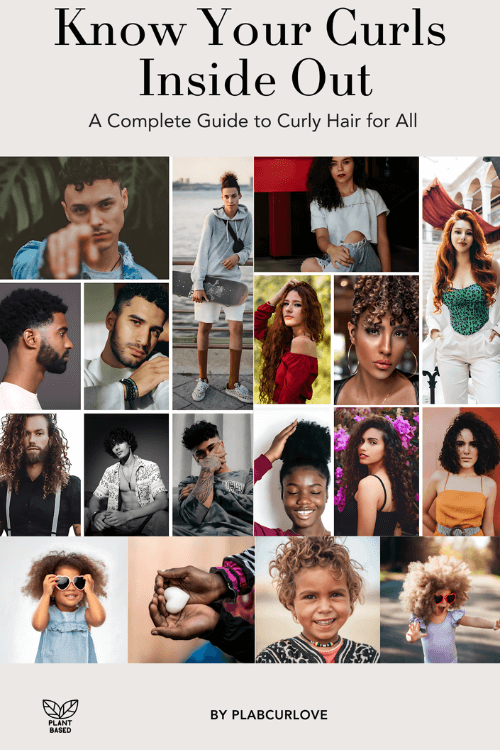Blog
7 Best Tips for Smooth Curly Hair

Caring for curly hair is a journey—it’s full of twists, turns, and tangles. Managing tangles can feel frustrating, but with the right techniques, products, and knowledge, you can keep your curls smooth, healthy, and full of life. Here are the 7 Best Tips for Smooth Curly Hair to help with managing knots, breakage, and frizz.
From prevention techniques to detangling methods, must-have products, and even lifestyle changes, this guide covers everything you need to make managing your curls easier. Let’s dive in!
Why Does Curly Hair Tangle More?
The Science Behind Curly Hair
Curly hair tangles more than straight hair because of its unique structure. The natural bends and twists create more friction between strands, which makes them prone to knotting. Additionally, curly hair is often drier because the scalp’s natural oils have a harder time traveling down the hair shaft. This dryness contributes to rough cuticles, which can lead to tangles.
1. Can Knots in Curly Hair Be Prevented?
Preventing Knots Altogether: Is It Possible?
The short answer is no, knots can’t be completely avoided. However, you can minimize tangles significantly by adopting certain practices that keep your hair smooth and hydrated.
How to Reduce Tangles in Curly Hair
- Finger Combing During Washing: While shampooing and conditioning, use your fingers to gently separate your hair and prevent clumps from forming.
- Satin or Silk Pillowcases: Switch to a satin or silk pillowcase to reduce friction while you sleep. Cotton pillowcases can cause your curls to rub together and tangle.
- Protective Hairstyles: Loose braids, buns, or pineapple styles can prevent your curls from tangling overnight or during physical activities.
- Hydrate Your Hair: Keeping your curls moisturized reduces dryness and brittleness, which are common causes of tangles.
2. What Is the Best Way to Detangle Curly Hair?
Detangling Without Breakage: Key Techniques
Detangling curly hair requires patience and care. Harsh pulling can lead to breakage and damage, so it’s essential to use the right tools and methods.
Step-by-Step Detangling Process
- Step 1: Detangle in the Shower
Always detangle curly hair when it’s wet and slippery with conditioner. This reduces friction and makes it easier to slide tangles apart.
- Step 2: Use the Right Tools
Invest in a wide-toothed comb or a detangling brush designed for curly hair. These tools work through knots gently without tearing the strands.
- Step 3: Work from the Ends Up
Start detangling at the ends of your hair and work your way up to the roots. This method prevents tugging and minimizes breakage.
- Step 4: Apply a Detangling Spray
A good detangling spray with slippery ingredients like aloe vera or marshmallow root can make the process much easier.
- Step 5: Take Your Time
Rushing through tangles can damage your curls. Be patient and work slowly to keep your hair healthy.
3. How Can You Prevent Breakage While Brushing?

Tips to Minimize Damage
Brushing curly hair can disrupt its natural curl pattern and cause breakage, especially if done incorrectly. Follow these tips to protect your curls:
- Avoid Brushing Dry Hair: Never brush curly hair when it’s dry. Instead, spritz it with water or use a leave-in conditioner to add slip before detangling.
- Use a Wide-Toothed Comb: This is the best tool for detangling curls without causing breakage.
- Start Small: Always detangle in small sections. This makes the process more manageable and reduces strain on your hair.
- Be Gentle: Treat your hair like silk. Rough handling will only lead to damage.
4. How Often Should Curly Hair Be Detangled?
Finding a Routine That Works
How often you need to detangle depends on your hair type, curl pattern, and lifestyle. Here are some general guidelines:
- Post-Wash Detangling: The best time to detangle is after washing your hair when it’s coated in conditioner. This provides maximum slip and minimizes breakage.
- Nighttime Detangling: If you frequently wake up with tangles, a quick nighttime detangling session can help. Apply a bit of leave-in conditioner or oil and gently comb through your curls before bed.
- Listen to Your Hair: If your curls stay relatively tangle-free between washes, you may not need to detangle daily. Adjust your routine based on your hair’s needs.
5. Which Products Help Prevent Knots?
Must-Have Plant-Based Products for Tangle-Free Curls
Using plant-based products can significantly help prevent knots and keep your curls smooth. Here are some essentials:
- Plant-Based Leave-In Conditioners: Opt for leave-ins with natural, lightweight ingredients like coconut oil, shea butter, or aloe vera to keep your hair moisturized and tangle-free.
- Curl Creams with Natural Humectants: Look for products featuring plant-derived humectants like glycerin, aloe vera, or agave nectar to attract moisture and reduce dryness.
- Detangling Sprays with Natural Ingredients: Sprays with slippery, plant-based ingredients such as marshmallow root or flaxseed provide excellent slip for tackling tangles.
- Deep Conditioners with Botanical Extracts: Regular deep conditioning treatments with ingredients like avocado, argan oil, or hibiscus can boost hydration and elasticity, minimizing knots.
6. Could Your Diet and Lifestyle Affect Knot Formation?

The Connection Between Hair Health and Lifestyle
Your diet and lifestyle play a significant role in your hair’s overall health, which can impact how prone it is to tangles. Here’s what to keep in mind:
- Stay Hydrated: Drinking enough water keeps your hair hydrated from the inside out, reducing dryness and tangling.
- Eat Nutrient-Rich Foods: A balanced diet with plenty of vitamins and minerals promotes healthy hair. Focus on plant-based foods rich in biotin (e.g., nuts, seeds, and sweet potatoes), vitamin E (e.g., spinach, avocados, and almonds), and omega-3 fatty acids (e.g., flaxseeds, chia seeds, and walnuts).
- Exercise and Stress Management: Regular exercise and stress reduction can improve your scalp health, essential for strong, tangle-free hair.
- Get Regular Trims: Split ends are notorious for causing tangles. Regular trims keep them in check and help your curls stay smooth and manageable.
7. What Are the Best Hairstyles to Reduce Tangles?
Protective Styles for Curly Hair
Certain hairstyles can prevent tangles while protecting your hair from damage. Here are some ideas to try:
- Loose Braids or Twists: These styles keep your curls contained and prevent them from rubbing together.
- The Pineapple: Gather your curls at the top of your head before bed to prevent friction and tangling overnight.
- Buns and Updos: These styles are great for keeping your curls smooth during physical activities or windy days.
Conclusion
Managing tangles and knots in curly hair doesn’t have to be a frustrating experience. With the right techniques, products, and habits, you can keep your curls smooth, healthy, and full of life. Start by adopting preventative measures like finger combing and using satin pillowcases. When detangling, be patient and use tools and products designed for curly hair. Don’t underestimate the power of protective hairstyles, regular trims, and a healthy diet rich in plant-based nutrition, as it provides essential vitamins and minerals to promote strong, vibrant curls.
Your curly hair journey is all about finding what works for you. With these 7 Best Tips for Smooth Curly Hair, you’re well on your way to luscious, manageable curls that shine with health. Embrace your curls and enjoy the beauty they bring—knots and all!
Ultimate Curly Hair Guide!

Transform your curls today with the ultimate guide to perfect curls—get your copy now!



